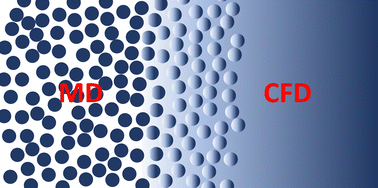Multiscale simulation of fluids: coupling molecular and continuum
Abstract
Computer simulation is an important tool for scientific progress, especially when lab experiments are either extremely costly and difficult or lack the required resolution. However, all of the simulation methods come with limitations. In molecular dynamics (MD) simulation, the length and time scales that can be captured are limited, while computational fluid dynamics (CFD) methods are built on a range of assumptions, from the continuum hypothesis itself, to a variety of closure assumptions. To address these issues, the coupling of different methodologies provides a way to retain the best of both methods. Here, we provide a perspective on multiscale simulation based on the coupling of MD and CFD with each a distinct part of the same simulation domain. This style of coupling allows molecular detail to be present only where it is needed, so CFD can model larger scales than possible with MD alone. We present a unified perspective of the literature, showing the links between the two main types of coupling, state and flux, and discuss the varying assumptions in their use. A unique challenge in such coupled simulation is obtaining averages and constraining local parts of a molecular simulation. We highlight that incorrect localisation has resulted in an error in the literature. We then finish with some applications, focused on the simulation of fluids. Thus, we hope to motivate further research in this exciting area with applications across the spectrum of scientific disciplines.

- This article is part of the themed collections: 2023 PCCP HOT Articles and 2023 PCCP Reviews


 Please wait while we load your content...
Please wait while we load your content...